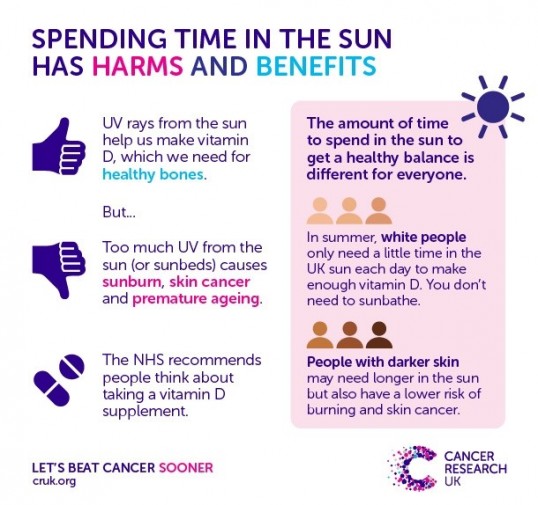Prevention and management of those at risk of skin cancer
GPs can identify those at high risk of melanoma, meeting the guidelines above and refer for routine risk estimation. Provide safe sun advice during skin consultations. When doing annual reviews for patients on immunosuppressants bring up self-checking techniques for skin cancer, offer skin checks looking out for SCCs. Suggest yearly review for those who have been diagnosed with BCCs given the increased occurrence rates for further BCCs in the next 3 yrs. Use promotional posters advising on safe sun campaign material from cancer research within the surgery.
Cancer research UK national campaign “Sunsmart”
The following extract is the cancer research UK advice on sun safe, balancing it with a need to make vitamin D from sun exposure. It should be signposted to all patients presenting with sun related skin problems.

Vitamin D is needed to maintain strong bones. UV rays from the sun are the main source of vitamin D in humans. Vitamin D can also be found in foods, though this is not in enough for human bodies to rely on. Vitamin D is present in foods such as egg yolks, oily fish like mackerel and sardines, fish liver oils and some fortified cereals.
A lack of vitamin D over long periods of time leads to softening of the bones causing rickets in children and osteomalacia in adults.
The government recommends people at risk of having low vitamin D levels should take a supplement, and that everyone should think about doing this over the winter.
What is a good balance of vitamin D?
Skin type, time of day, time of year, and where you are in the world all affects the amount of healthy sun absorbed. It is not possible to give a ‘one size fits all’ recommendation on how much sun is needed to make enough vitamin D. People with darker skin tones need longer in the sun, but also have a lower risk of sunburn and skin cancer. Most people with white skin should make enough vitamin D from short, casual exposure without sun protection going about daily life. To gain a good balance of sun safely you shouldn’t have to redden or burn your skin to make enough vitamin D. This balance is about getting to know your own skin and understanding how long you can spend outside before risking sunburn under different conditions.

